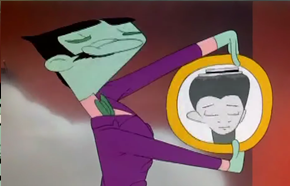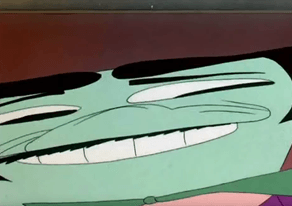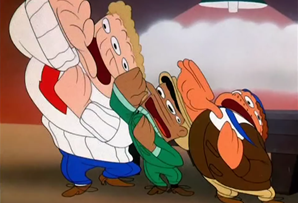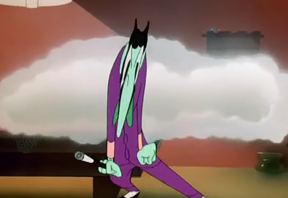The act of animating has been around since Ancient times, where the furthest we had in terms of art was drawings on the sides of cups, which was what historians have argued was the first example of animation.
A bowl made of bronze which was found in the archeological site, Shahr-e Sukhteh in Iran. Archaeologists have dated it back all the way to 3,000 B.C.
The other ancient example of animation is Leonardo da Vinci’s Vitruvian Man drawing which has multiple arm and legs, implying movement which is from 1500 A.D.
As the Industrial Revolution began to pick up steam in the late 1700s so did the new and innovative ways people were trying to create animations such as the Magic Lantern.
The Magic Lantern was an image projector made in 1603 which used sheets of pane glass to project pictures kept on the glass onto a wall or screen, many of the sheets could be put in a way that gives the illusion of movement, the Magic Lantern is known as the first animation that was projected.
Next was the Thaumatrope, which was an invention made in 1824 which contained an image on each side of the disk like centre that could be rotated by twisting the handles, by twisting the image between the two sides you could see a combined image, which could also give the illusion of movement, much like the Magic Lantern except with only two frames.
In 1868 the flip book, or kineograph, became more popular with the general population and is claimed to be the more successful inspiration for early animators than the earlier machines created in this era, this could be because of a flip book being easy and cheap to make while the other machines could have been fairly big commodities which were kept by professionals rather than being an everyday household object.
The Movieola also known as the Praxinoscope was made in 1877, it rotated images by using wheels to move the images around and create the sense of movement, it is considered to show the prototype for the first cartoon.
When the early 20th century came around theatrical releases of cartoons began, most notably in the USA and France, two countries that had many significant figures in the history of animation and film in general.
From this theatrical success more animators became ambitious and turned to creating their own companies, the most successful of the era was Bray Studios, based in New York which would help the creators of the characters Mighty Mouse, Betty Boop and Woody Woodpecker.
There is much debate over what is the first animated film since the technicalities of what makes an animated film differ from person to person, for example, what is commonly accepted to be the first animated film was Humorous Phases of Funny Faces, made in 1906 by a newspaper cartoonist named J. Stuart Blackton, however there was at least three animated films before this one, created by the same man who invented the previously mentioned Praxinoscope, this man was a French scientist Charles-Emile Reynaud. The three animated films he made were, in order:
- “Pauvre Pierrot” (Poor Pete) – which is the only surviving example that used 500 frames to create it, the film itself was uploaded to Youtube and can be seen here
https://www.youtube.com/watch?v=Ib3xjIWiYZY - “Le Clown et Ses Chiens” (The Clown and His Dogs) – which used 300 frames
- “Un Bon Bock” (A Good Beer) – which used 700 frames
To actually create the animations, Reynaud created each image individually and painted them directly onto the frames of a strip of transparent gelatine which had film perforations on the edges, which was then run through his projection system.
Humorous Phases of Funny Faces used a much different approach to animation and while its placement as the first ever animated film is still debatable, Humorous Phases of Funny Faces holds the title of first animated film to use the single frame method of animating by using stop motion photography of his drawings and shown at 20 frames per second.
This film was then followed by the 1908 animation ‘Fantasmagorie’ from France which is seen as the first fully animated cartoon which had full hand drawn, frame by frame animation.
A comic-strip animator named Winsor McCay created three famous comic strips, these were Dreams of the Rarebit Fiend, Little Sammy Sneeze, and Little Nemo in Slumberland. The reason I bring McCay up is that he helped to define the industry and was the first to establish the technical method of animating graphics which helped shape what we use today, his first endeavor into animation was Little Nemo in Slumberland that came out in 1911 and had 4,000 hand-drawn frames.
McCay in 1914 also created what is known as the first cartoon character with a large appeal to mass audiences, this character was a Brontosaurus named Gertie who originated from the animated cartoon Gertie the Dinosaur made in 1914 which used 10,000 drawings, backgrounds included. Gertie the Dinosaur was where McCay created what’s seen as the earliest example of combining live action and animation, as well as being the first interactive animated cartoon, the reason it was seen as interactive was because the cartoon showed a real person stepping on Gertie, a cartoon’s, mouth and then climbing onto Gertie’s back for a ride.
Also in 1919 a man named Joh Bray opened John Bray Studios, which revolutionized the way animation was created. Earl Hurd, one of Bray’s employees patented the cel animation technique. Cel animation is an animation form created by animating moving objects on transparent celluloid sheets. Animators photographed these sheets over a static background image to generate the sequence of images which when put together would create movement. This was one of the main thing which allowed John Bray Studios to create Colonel Heeza Liar, considered the first animated series.
As well as this, in 1919 the first cartoon character to become extremely famous was the anthropomorphic Felix the Cat from Pat Sullivan Studios.
Walt Disney
Disney was born on December 5, 1901, in Hermosa, Illinois. He and his brother Roy co-founded Walt Disney Productions, which is still to this day the most popular animation company in existence.
Disney was well-known as an innovator for his creation of the character Mickey Mouse, Donald Duck and Goofy. Disney himself originally voiced Mickey in Steamboat Willie. Disney is also known as a very good business man and entrepreneur thanks to his success opening up the original Disneyland Theme Park.
In 1930, Warner Brothers Cartoons was founded and they created Loony Toons, created by Hugh Harman and Rudolf Ising, along with its sister series, Merrie Melodies which ran from 1931 to 1969 during what is known as the Golden Age of American Animation for the rise in popularity of Disney and Warner Brothers among other classic American Animation companies and shows. Three of the Merrie Melodies shorts won the Academy Award for Best Animated Short Film.
In 1937 Snow White and the Seven Dwarfs was released By Walt Disney. Snow White is famously remembered for being the first full length animated feature film which also used hand-drawn animation.
From 1960 to the 1980s an era called ‘The American Television Era’ was created, this was when the animation industry began to change so that they’d stay relevant as television continued its rise in popularity for American families. Many famous TV cartoons would be created during this period and would use a limited animation style. Limited animation is the use of less detailed or more stylized drawings and methods of movement usually a choppy movement animation. Limited animation uses fewer drawings per second, which resulted in less fluid animation.
The reason companies used limited animations styles was because animation was very expensive and time costing, so to lighten the load on finance and time animators took shortcuts that have become stylistic choices which are staples of any animation, from Western to Japanese animation. These shortcuts include smear frames, in which the character would be “smeared” across the screen for a split second to emulate fast movement, you’ll find no better example of smear frames than Warner Brothers very own Merrie Melodies, more specifically the episode ‘The Dover Boys’.




There are typically two types of smear frames, one is when the body is exaggerated and stretched out in the movement arc it’s going in, this type of smear frame is usually used for more large and exaggerated movements such as full body movements.
The other smear frame will have the thing which is moving drawn in numerous locations so as to create the movement that will happen. usually this type of smear frame is used for smaller movements and movements of smaller areas, such as a single limb or area, this type will sometimes include lines indicating how the movement happens which adds to the effect since a smear frame traditionally happens for only a split second so the brain can’t process it properly and believes it to be the correct movement.
This style is still used today, however since animation is now cheaper it’s more to make slapstick more fast paced and to keep movements fast, as I said the influence of smear frames from this era has effected both Western and Japanese animation styles.
It’s quite interesting to see how something that originally was started to cut the budget and time needed for shows has become a stylistic choice now as we’ve moved on from hand drawn animation. I will probably follow in these ideas and also use smear frames since they cut back on time and are a good way to have fast paced movement in less frames.
In 1960 an animator named Hanna-Barbera released The Flintstones, the first animated series on prime-time television, Flintstones was closely followed by Yogi Bear, another Hanna-Barbera creation in 1961.
From 1980 to Modern Day the era of animation is called ‘Modern American Era’. The modern American era famously brought CGI to the animation industries, true in its beginning it was fairly ugly and texture less compared to modern times but it was the beginning of a whole new form of animation unlike any that’d come before it because CGI, or Computer Generated Imagery, was in 3D.
In 1984 A short film called ‘The Adventures of Andre & Wally B’ was released it is the first fully CGI-animated film, created by a company called The Graphics Group, the pioneer that lead Pixar into existence with its first film Toy story from 1995, Toy Story was the first fully computer-animated feature film to be released, it is also the film that made CGI a valid and popular form of animation that every animation company began wanting a slice of to get in on the popularity that was quickly rising from Toy Story.
From Toy Story CGI came a long way and had many upgrades put into it thanks to the work of skilled and talented artists, programmers and film companies that kept the popularity of CGI films going.
References:
http://www.payvand.com/news/10/aug/1084.html
http://history-of-animation.webflow.io/
https://www.futurelearn.com/courses/explore-animation/0/steps/12225





